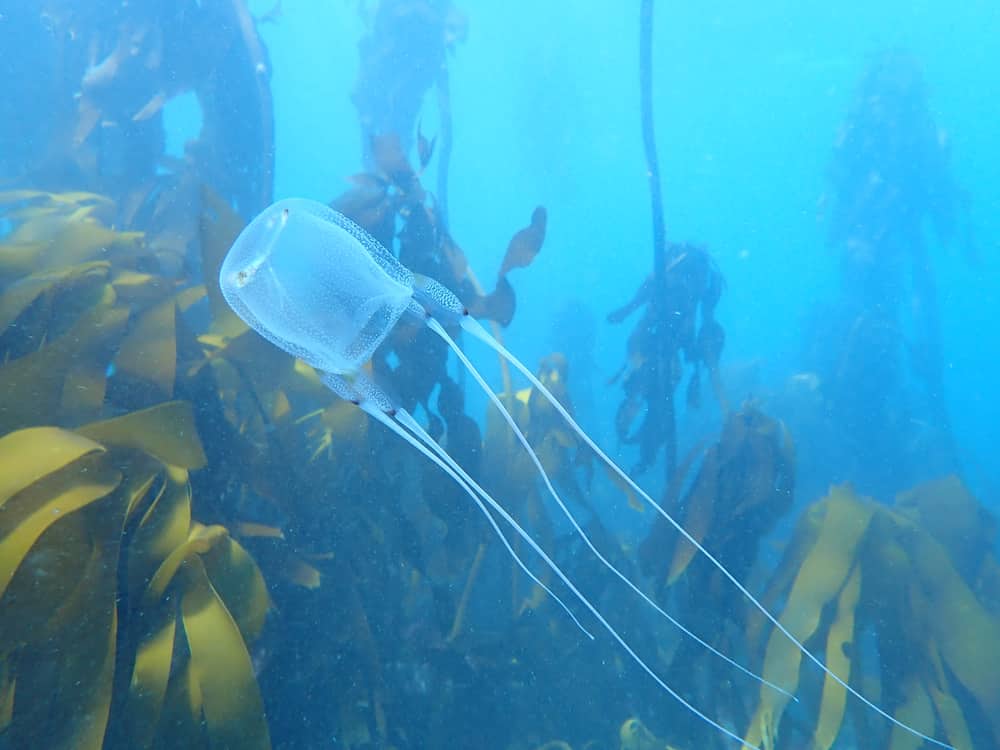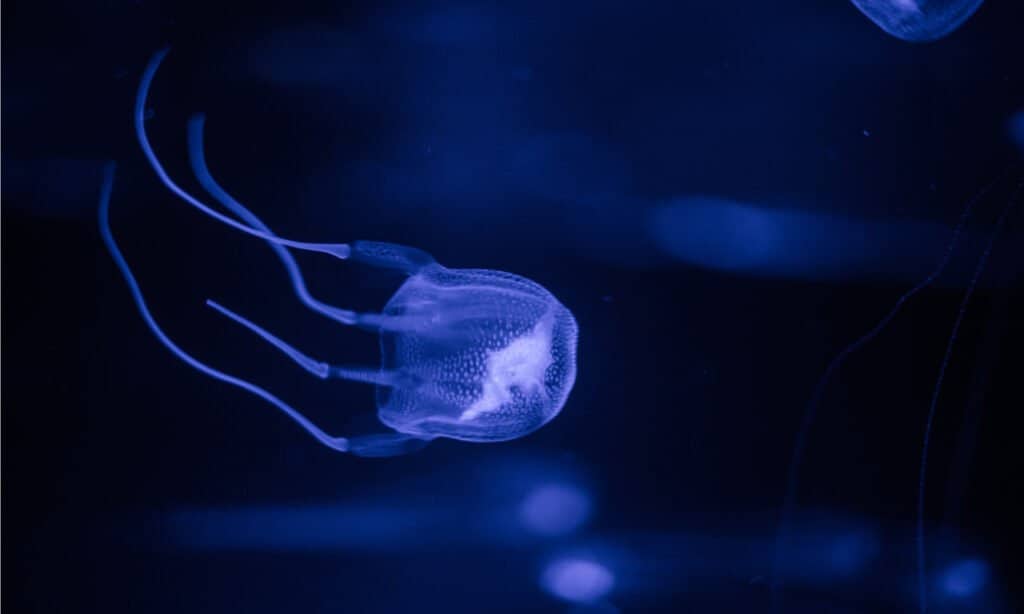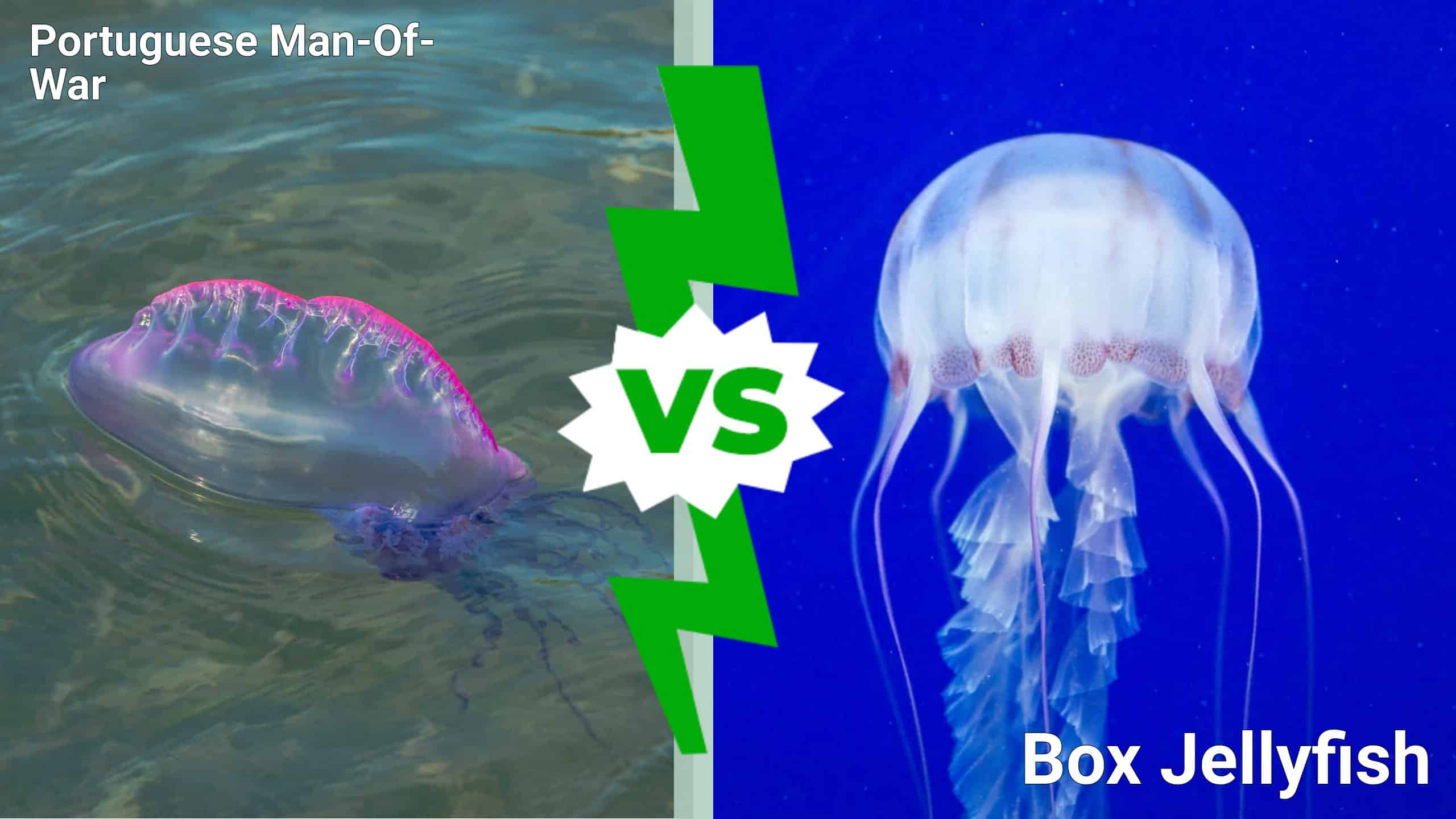There’s a massive difference in their size but they’re both venomous and jelly-like, moving in the water gracefully and alluringly. In a battle between a Portuguese man-of-war vs. a box jellyfish, which deep sea creature emerges victorious? Let’s find out!
Comparing a Portuguese Man-Of-War vs. Box Jellyfish
| Portuguese Man-Of-War | Box Jellyfish | |
|---|---|---|
| Size | Float: six inches tall Tentacles: up to 165 feet long | 12 inches in diameter; up to 10 feet long |
| Speed and Movement Type | Depends on the speed of the water | Up to 4.6 miles per hour |
| Defenses | Venomous nematocysts | Venomous stinging tentacles |
| Offensive Capabilities | Long tentacles that sting | Stinging tentacles, swallowing prey |
| Predatory Behavior | Attacks when something touches it | Lures prey with tentacles, traps prey, stings, and swallows |
What Are the Key Differences Between a Portuguese Man-Of-War and a Box Jellyfish?
The Portuguese man-of-war and the box jellyfish look kind of similar. However, the Portuguese man-of-war is not a jellyfish. Not only is it not a jellyfish but it’s also not a single organism. It’s made up of polyps that all work together and create this jellyfish-like sea creature. Unlike the box jellyfish, the Portuguese man-of-war can’t swim.
The polyps don’t move on their own and can only be carried by the ocean. Both of these marine creatures have stinging cells known as nematocysts, which are toxic upon touch. They use these nematocysts both when defending themselves and when hunting. Both of them use their tentacles to trap prey like invertebrates, crustaceans, and small fish to feast on.

Beautiful and dangerous, the Portuguese man-of-war is venomous.
©NFKenyon/Shutterstock.com
Portuguese Man-Of-War vs. Box Jellyfish: Size
The Portuguese man-of-war has a float that is, on average, six inches tall. The reason it appears larger is because its tentacles can stretch out well over 100 feet long. Box jellyfish do not reach the same size as a Portuguese man-of-war. These jellyfish can be about a foot in diameter and may have tentacles that grow up to 10 feet long.

The box jellyfish moves freely on its own and can reach speeds up to 4.6 miles per hour.
©Katherine Wallis/Shutterstock.com
Portuguese Man-Of-War vs. Box Jellyfish: Speed and Movement Type
The Portuguese man-of-war, though large and seemingly always moving, cannot move on its own. It’s made up of many different organisms called polyps which do not move on their own. Though they cling together, they cannot force movement in the water. Instead, they depend on the flow of water to keep them moving. On the other hand, the box jellyfish moves freely on its own. It can even reach up to 4.6 miles per hour!
Portuguese Man-Of-War vs. Box Jellyfish: Defenses
When it comes to defenses, both the Portuguese man-of-war and the box jellyfish have the same way of defending themselves. They rely on their long tentacles that have venomous nematocysts to attack predators. The box jellyfish is known for its extremely powerful venom and although the Portuguese man-of-war also has a strong venom, the box jellyfish’s reputation points to it being the most venomous of the two.
Portuguese Man-Of-War vs. Box Jellyfish: Offensive Capabilities
Because of the structure of both the Portuguese man-of-war and the box jellyfish, there aren’t many ways for them to express their offensive capabilities. In fact, their offensive capabilities are the same as their defenses. Ultimately, they use their long tentacles to sting their prey, trap it, and consume it.

The box jellyfish is the world’s deadliest jellyfish.
©Dewald Kirsten/Shutterstock.com
Portuguese Man-Of-War vs. Box Jellyfish: Predatory Behavior
The Portuguese man-of-war doesn’t have a lot of say in what it hunts. Instead of being able to swim and find prey on their own, these organisms that cling together rely on where the water takes them. So, when something approaches them, they take the opportunity to immediately attack it. This is how the Portuguese man-of-war sustains itself.
Box jellyfish are different because they do have the capacity to swim in the water. They can hunt for their preferred prey and lure it with their tentacles. Once the prey is close enough, they trap it, sting it, and swallow it.
Who Would Win in a Fight Between a Portuguese Man-Of-War and a Box Jellyfish?
In a fight between a Portuguese man-of-war and a box jellyfish, a box jellyfish is most likely to win. A box jellyfish has more control over its body and is able to swim, attack, swim away, and attack again. A Portuguese man-of-war, under these circumstances, would not be able to flee and would have to rely solely on its ability to sting.
The box jellyfish has extremely powerful venom that could potentially severely damage a Portuguese man-of-war. However, it’s important to note that this is merely a conceptual battle. These two sea creatures are highly unlikely to engage in a fight. Their stinging tentacles are meant to defend and sustain themselves by catching and immobilizing prey for consumption.
Thank you for reading! Have some feedback for us? Contact the AZ Animals editorial team.








